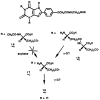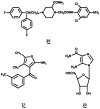Novel therapeutics acting via purine receptors
- PMID: 2018549
- PMCID: PMC3561777
- DOI: 10.1016/0006-2952(91)90555-j
Novel therapeutics acting via purine receptors
Abstract
A recent conference entitled Purines in Cell Signalling: Targets for New Drugs, held in Rockville, Maryland, in September, 1989, was one indication of the increasing interest in developing agonists and antagonists of P1-(adenosine) and P2-(ATP) purinoceptors [1] as potential therapeutic agents. Extracellular adenosine, acting at its membrane bound A1 and A2 receptors, is a ubiquitous modulator of cellular activity. The purine can arise from several sources including ATP hydrolysis by ectokinase activity in the region of the nerve terminal [2] and from S-adenosylhomocysteine [3] and ATP within the cell. Together with its more stable analogs, adenosine is a potent inhibitor of neurotransmitter release in both the central and peripheral nervous systems, and in cardiac, adipose and other tissues. Adenosine can also affect blood pressure and heart rate as well as modulate the function of the immune, inflammatory, gastrointestinal, renal and pulmonary systems, either via its effects on transmitter release or directly via receptor mechanisms altering intracellular transduction processes.
Figures



Similar articles
-
Endogenous adenosine delays the onset of hypoxic depolarization in the rat hippocampus in vitro via an action at A1 receptors.Brain Res. 1993 Apr 23;609(1-2):313-5. doi: 10.1016/0006-8993(93)90888-t. Brain Res. 1993. PMID: 8508312
-
Approaches for designing and discovering purinergic drugs for gastrointestinal diseases.Expert Opin Drug Discov. 2020 Jun;15(6):687-703. doi: 10.1080/17460441.2020.1743673. Epub 2020 Mar 31. Expert Opin Drug Discov. 2020. PMID: 32228110 Review.
-
Purine receptors in mammalian tissues: pharmacology and functional significance.Annu Rev Pharmacol Toxicol. 1987;27:315-45. doi: 10.1146/annurev.pa.27.040187.001531. Annu Rev Pharmacol Toxicol. 1987. PMID: 3555319 Review. No abstract available.
-
Potential therapeutic targets in the rapidly expanding field of purinergic signalling.Clin Med (Lond). 2002 Jan-Feb;2(1):45-53. doi: 10.7861/clinmedicine.2-1-45. Clin Med (Lond). 2002. PMID: 11871639 Free PMC article. Review.
-
Role of adenosine in ischemic preconditioning in rats depends critically on the duration of the stimulus and involves both A(1) and A(3) receptors.Cardiovasc Res. 2001 Sep;51(4):701-8. doi: 10.1016/s0008-6363(01)00321-2. Cardiovasc Res. 2001. PMID: 11530103
Cited by
-
Adenosine receptors: pharmacology, structure-activity relationships, and therapeutic potential.J Med Chem. 1992 Feb 7;35(3):407-22. doi: 10.1021/jm00081a001. J Med Chem. 1992. PMID: 1738138 Free PMC article. Review. No abstract available.
-
Current Understanding of the Role of Adenosine Receptors in Cancer.Molecules. 2024 Jul 26;29(15):3501. doi: 10.3390/molecules29153501. Molecules. 2024. PMID: 39124905 Free PMC article. Review.
-
Synthesis and study of 5'-ester prodrugs of N6-cyclopentyladenosine, a selective A1 receptor agonist.Pharm Res. 2001 Apr;18(4):531-6. doi: 10.1023/a:1011018730459. Pharm Res. 2001. PMID: 11451042
-
Deoxyribose analogues of N6-cyclopentyladenosine (CPA): partial agonists at the adenosine A1 receptor in vivo.Br J Pharmacol. 1995 Oct;116(3):1957-64. doi: 10.1111/j.1476-5381.1995.tb16398.x. Br J Pharmacol. 1995. PMID: 8640332 Free PMC article.
-
Adenosine A1 and A2 receptors: structure--function relationships.Med Res Rev. 1992 Sep;12(5):423-71. doi: 10.1002/med.2610120502. Med Res Rev. 1992. PMID: 1513184 Free PMC article. Review. No abstract available.
References
-
- Jacobson KA. Adenosine (P1) and ATP (P2) receptors. In: Emmett JC, editor. Comprehensive Medicinal Chemistry. Vol. 3. Pergamon Press; New York: 1990. pp. 601–642.
-
- Pearson JD. Ectonucleotidases. Measurement of activities and use of inhibitors. Methods Pharmacol. 1985;6:83–108.
-
- Stone TW, Lloyd HGE, Newby AC. Adenosine release. In: Williams M, editor. Adenosine and Adenosine Receptors. Humana Press; Clifton, NJ: 1990. pp. 173–223.
-
- Honey RM, Ritchie WT, Thompson WAR. The action of adenosine upon the human heart. Q J Med. 1930;23:485–490.
Publication types
MeSH terms
Substances
Grants and funding
LinkOut - more resources
Full Text Sources
Other Literature Sources

